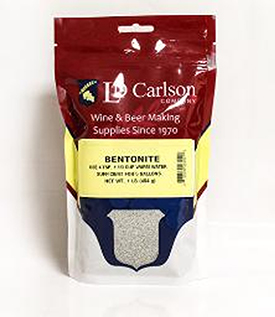What is Bentonite and How Is It Used in Winemaking?
Posted by Matteo Lahm on 25th Sep 2023
As a home winemaker, so many of the processes you use have ancient origins, but there is one that is a very recent innovation. Though it lacks the historicity of processes like using sulfites, which can be traced back to the ancient Romans, it is no less important or ingenious. You've likely encountered bentonite, but do you truly understand what it is, where it originates, and why it came to be a crucial component in your winemaking process? Let's embark on an enlightening expedition into the realm of this volcanic virtuoso in the world of winemaking.
Bentonite is a type of clay that hails from volcanic ash. Yes, you got it right. Your wine is being refined by the same material that once erupted from a volcano. It's as if each bottle contains a hint of Vesuvius, minus the catastrophic consequences and with no negative impact on the taste of your wine.
This volcanic marvel was first unearthed in Fort Benton, Wyoming, which is how it got its name. But it's not exclusive to the American frontier. Bentonite is a globetrotter, found in diverse locations such as Greece, India, and Australia.
The discovery of bentonite and its application in winemaking is credited to an American geologist named Wilbur C. Knight. In the late 19th century, Knight was exploring the rock formations around Fort Benton, Wyoming, when he stumbled upon a unique clay that swelled when it came into contact with water. He named this clay "bentonite" after the nearby fort. However, it wasn't until the mid-20th century that the use of bentonite in winemaking became widespread. A winemaker, experimenting with ways to improve the clarity of his wines, decided to try adding bentonite. He found that the clay effectively removed the proteins that caused haziness in his wines, and the practice quickly caught on. Today, bentonite is a staple in winemaking, thanks to its ability to improve the clarity and stability of the final product.
Now, let's uncork the reason why this volcanic ash derivative is so vital in winemaking. It's all about the proteins. Bentonite has a unique knack for attracting and binding to the proteins that can make your wine hazy. Consider it as the security guard at a bar, escorting the rowdy proteins out.
This is especially beneficial in white and rosé wines, which are more susceptible to protein haze. Red wines, with their higher tannin content, are somewhat more immune to this problem. However, bentonite doesn't discriminate and can be used in red wine production as well though it is much less often. Bentonite is used less frequently in red wines primarily for two reasons. First, red wines inherently have higher tannin levels, which naturally bind to and precipitate proteins, reducing the risk of protein haze. This makes the use of bentonite less necessary in red wines compared to whites or rosés.
Secondly, the use of bentonite can potentially strip some color from red wines. The clay doesn't discriminate between what it binds to and can inadvertently latch onto the anthocyanins, the compounds responsible for the red and purple hues in red wines. This could lead to a slight loss of color intensity, which is undesirable in red wines where color plays a significant role in the overall sensory experience.
So, while bentonite can be used in red wines, it's often used judiciously or substituted with other fining agents that don't risk altering the wine's color.
So, how exactly does bentonite work? It's added during the fermentation process, where it begins binding to those troublesome proteins. Once it's done its job, the bentonite settles at the bottom of the fermentation vessel, dragging the proteins down with it. The result? A clear, bright wine that's ready for bottling.

Bentonite, chemically known as aluminum phyllosilicate, is a type of clay that consists of microscopic crystals. These crystals are made up of layers of silica tetrahedra (a pyramid-like structure with four faces) sandwiching a layer of alumina octahedra (an eight-faced structure). This unique structure gives bentonite its signature property of swelling when it comes into contact with water. When hydrated, the water molecules penetrate between the layers, causing the bentonite to expand and become a gel-like substance.
This swelling property is what makes bentonite so effective in clearing your wine. When added to the wine, the bentonite particles disperse throughout the liquid and carry a negative charge. Proteins in the wine, which are positively charged, are attracted to the negatively charged bentonite particles. This attraction causes the proteins to bind to the bentonite. As the bentonite particles swell, they become heavier and settle to the bottom of the wine vessel, taking the bound proteins with them. This process, known as flocculation, effectively removes the proteins that can cause haziness in your wine, leaving you with a clear, bright product.
Now, let's talk about how to use it. Bentonite should be hydrated before use. Mix it with warm water and let it sit for 24 hours. The general rule of thumb is to use 1-2 teaspoons of bentonite per gallon of wine. However, it's always wise to favor using less rather than more, as too much can strip your wine of its flavor and aroma. Add the hydrated bentonite to your wine before fermentation begins, and stir thoroughly to ensure it's evenly distributed.
When working with fresh grapes for red wine, the process of adding bentonite does indeed require a bit of a different approach. Since it's challenging to stir the bentonite into the crushed grapes directly, it can be added midway through fermentation when making red wine that is fermented on the skins. At this stage, the must (the mixture of grape juice, skins, and seeds) is more liquid and easier to stir, which allows for better dispersion of the bentonite.
So, there you have it. Bentonite: the volcanic ash derivative that's silently working backstage to make your wine the star of the show. It may not be the most glamorous part of winemaking, but it's undeniably one of the most crucial. And remember, without it, your wine might resemble a lava lamp rather than a fine vintage.
So, the next time you're enjoying a perfectly clear glass of wine, spare a thought for the hard work of this modest clay. After all, behind every great show, there's a great stage manager.


